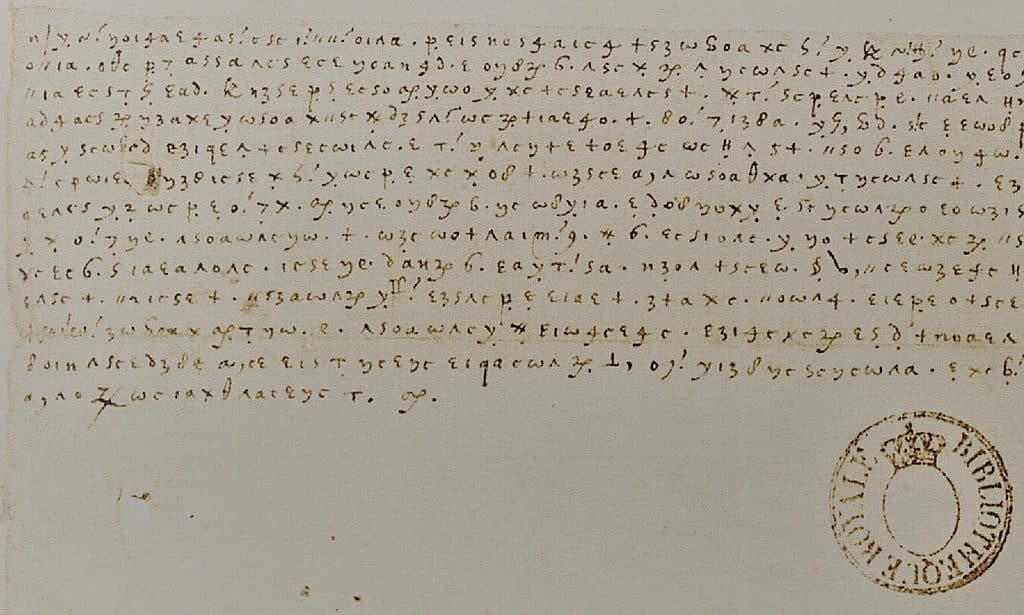A group of codebreakers have found and deciphered a trove of lost letters written by Mary, Queen of Scots, a legendary Scottish monarch that inherited the throne when she was just six days old. The letter was sent to an ally during her imprisonment in England by Queen Elizabeth I, which was also Mary’s cousin.
The secret letters, found in France National Library in Paris and written in an elaborate code, come over 400 years after Mary’s death by execution.

The 57 secret letters, sent from Mary to the French ambassador in England between 1578 and 1584, were archived in an unmarked file and mistakenly placed in a part of the library involved with Italian affairs. When researchers saw the letters, it was clear they had no connection with Italy. They were written in French and were ciphered.
George Lasry, a computer scientist and cryptographer from France, joined forces with Norbert Biermann, a pianist from Germany, and Satoshi Tomokiyo, a physicist from Japan, to crack the code behind the documents. Lasry is a member of the DECRYPT Project, dedicated to mapping, digitizing, transcribing, and deciphering ciphers.
“This is truly an exciting discovery,” Lasry said in a statement. “Mary, Queen of Scots, has left an extensive corpus of letters held in various archive. “There was prior evidence, however, that other letters from Mary Stuart were missing from those collections, such as those referenced in other sources but not found elsewhere.”
Cracking Mary’s code
Mary Stuart was born Queen of Scotland in 1542 and spent most of her life imprisoned. First in Scotland by Protestant revolutionaries and then by Queen Elizabeth I. She was Catholic and was involved in several Catholic rebellions, as seen in her letters. She was eventually beheaded as a Catholic threat to the English throne (which was then protestant).
These particular letters were sent by Mary Stuart to Michel de Castelnau de Mauvissière, the French ambassador to England in the mid-16th century and a known Catholic ally. Historians had previously suspected they were in cahoots. The letters have over 50,000 words, revealing new insights into the queen’s personal views.
The researchers worked for over 10 years to find and understand the letters. They found verbs and adverbs that used a feminine form, mentions of captivity, and a keyword, Walsingham. This refers to Sir Francis Walsingham, the queen’s secretary. Altogether, this suggested they had found Mart Stuart’s long-lost correspondence.
They used complex methods to decipher the letters, including linguistic analysis, manual codebreaking, and computer algorithms. It was like solving a large crossword puzzle, Lasry said. While initially, they could only break 30% of the text using the computer algorithm, then they also analyzed the symbols manually and tested their meaning.
Mary’s communication with the outside world while imprisoned was an open secret of the time. She wanted to protect her letters from being intercepted and ready by hostile parties. However, she wasn’t always successful. A spy intercepted a letter in 1586 of her attempt to support a plot. The next year she was executed for treason.
Mary wrote regularly about the conditions of her captivity and her poor health. She regretted that the negotiations with Elizabeth I weren’t done in good faith. Mary also detailed her dislike of Walsingham and of Robert Dudley, a favorite of her cousin. She also described in the letter how she tried to bribe the queen’s officials.
“Upon deciphering the letters, I was very, very puzzled and it kind of felt surreal,” said Lasry in a statement. “We have broken secret codes from kings and queens previously, and they’re very interesting but with Mary Queen of Scots it was remarkable as we had so many unpublished letters deciphered and because she is so famous.”
Fate was not kind to Mary, Queen of Scots, and her execution marked a pivotal point in British history — paving the way for what was already a bloody conflict between the English and the Scottish.
Up next, the researchers would like for the letters to be further analyzed by historians so as to better understand Mary’s years in captivity. “We only provide an initial interpretation and summaries of the letters,” Lasry said. They would also like to dig deeper into other collections of letters in the library in France for further research.
The study was published in the journal Cryptologia.


